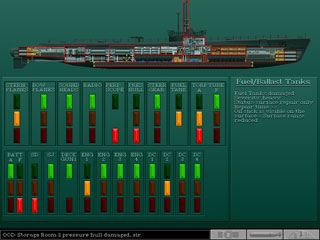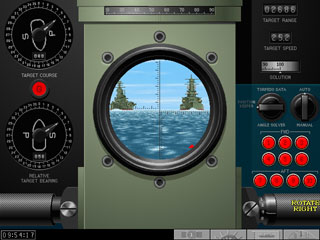

History: In the beginning, God created Submarine Simulators. God saw what he had done, and he blessed them, and said they were good. Down through the years, we have seen submarine simulators on the Atari 800, Microprose’s Silent Service for Atari 800 and C64, and Silent Service II for IBM. We have seen Red Storm Rising, 688 Attack Sub, Red Storm Rising, Dynamix’s Aces of the Deep and NovaLogic’s Wolfpack, and we blessed them, and said they were good.
Submarine spent up to 10 weeks in an iron coffin searching for ways to reach from beneath the waves to take out the cargo and war ships of the enemy. Starting in 1941 in the Pacific, the submarine commanders and carrier captains were alone in their one sided battle against the overpowering forces of the Japanese.
Submarine simulators, like flight simulators, have a pretty entrenched interface system. You must have a place for the burgeoning commander to keep his medals, records of sunk tonnage, and history of his rise to prominence, you need to have certain functions and stations that you can command from, like the conning tower and bridge. You need to have a map view. Fortunately, SSI’s Silent Steel has taken notice of the passage of time, history, and development, and has not forgotten its lessons of history.
Plot: You take the role of a commander of a U. S. submarine in the
Pacific during world war two.

Missions and Campaign: Play individual missions or a string of randomly generated campaign missions. Missions have you steal into enemy harbors, prowl the fishing lanes, rescue downed aviators, defense against Japanese sub busting task forces, and Special Operations. Some of the saved missions, like "Bud Gruner and the Agano," "Sink the Shinano," "S-38 in Lingayen Gulf," "Halibut vs. The Ise," "Sailfish vs. Chuyo," and "Parche vs. Everybody" will help hone your skills if taken progressively. These scripted and fixed mission are also a lot of fun to play with.
The career can start at a variety of time periods. If you wish, you can play out the entire war, changing submarines until you have commanded them all. You cannot play from the Japanese perspective, since that would be a destroyer game. Subs rarely hunt subs.
Successful careers and missions do not give you much eye candy or fanfare. It would have been nice to reward the commanders for a job well done, even if the task of blowing things up is a reward in itself.
Time compression and autopilot: There is a lot of time saved when you come out of harbor, you are not given the option of sailing out to sea even if you wanted to. The up to 256 time compression factors and short exits and entrances to ports eliminate the need for an auto-pilot.
Difficulty levels: Novice, intermediate, and expert difficulty levels, variable crew expertise, enemy strength, and other factors adjust to give the most innocent swabbie and the most grizzled submarine Captain a white knuckled ride. The charts lack the ability to set waypoints or depth information to prevent running aground.
Boats you drive: Available subs include S-boars, Barracuda, Narwhal, P Class, Aalmon, T Class, Gato, Balao and Tench. There is no cheat that will make boats or weapons available before the correct historical date. You will fight 40 different enemy types organized in convoys of up to 20 ships.
Weapons: Be sure to check out the documentation relating to the Mk 10, Mk 14, and Mk 18 torpedoes. The deck guns can be fired automatically or manually when surfaced to finish off helpless convoy ships once the escorts are eliminated.
Artificial intelligence (AI): Destroyer captains are doggedly persistant in their pursuit of your submarine, you must out smart them or you will be going to the bottom quickly. The manual lacks destroyer evasion techniques section which is essential to survival in this game.
Realism: The Torpedo Data Computer (TDC), charts, surface and air radar
systems, torpedo loading and status screen, and damage control center
are extremely accurate. The TDC allows you to set gyro angle, torpedo
depth, torpedo speed, and offset angle.

Graphics: SVGA bit-mapped, 256-color graphics are highly detailed and represent pictures that are accurate for the time period created with Smacker video technology. These interiors are good enough to be pictures of the real thing. The graphics of the bridge are spectacular with the sun rising and setting, the moon phases, cloud cover, and intricate detailing of the structures of coastal cities.
Animation: Authentic WWII film footage and cinematics throughout.
Music score: Original sound track
Voice actors: There is narration. The 16 one-third screen size, matted, digitized video interviews with veteran WWII submarine commander "Bud" Gruner are informative with important hints on staying alive in the game and in a real sub, reminding me of the Discovery Channel programs about WWII. Also read the manual biographies of commanders of other boats.
Sound effects include convincingly real sounds of torpedoes passing by, motor noises, sonar pings, ships screws turning, the pinging metal under water and finally explosions. Absence of crush depth audio clues and hull stress creaking is a bad omission.
Mutiplayer mode: Unfortunately there are no plans to come up with a multiplayer internet version where Commanders could hunt in packs with other Commanders. There is a dreadful trend in multi-player games away from cooperative or team play against a common enemy. This glaring omission is hard to fathom, since I know many people who are beginning to tire of tearing out the throat of everything that moves in a game.
The Future Looks Bright: Mission and campaign expansion disks and patches improving and increasing the play value are promised
Hints: Stay silent and submerged and slowly get close enough to sink an important ship, about 1,000 yards or less. Fight at night where not only the water but the darkness will help you escape. Ambush by sitting in the line of travel and waiting for the convoy to overtake you is the best course of action. Shoot with several seconds between each torpedo. Shoot and scoot: run after hitting one or two targets. Stay around too long and you will die at sea. Use aft torpedo tubes to kill pursuers while zigzagging up, down, and side to side to avoid detection. Descend below the thermocline or to a 125% of test depth to run then rig for silent running. Zigzag with the run fast, drift, and turn tactic. Stragglers and undefended convoys are the easiest way to increase tonnage, and often the best targets. Fire at an oblique angle to the target since the game accurately simulates the problems of perpendicular detonation with the torpedoes. Get patch v1.01 to help evade destroyers better. In a small convoy with one destroyer, kill him first and get the others later.
References:
http://w3pca.pcaction.de/pcg0696/review/silent
Editors, www.cdmag.com/simulation_vault/silent_hunter_review/page1.html, 4.5/5 (90%).
PC Gamer, volume 3, number 7, pg. 143-144.
Wants to be quoted: Fred G. Nardei, Jr., www.mortimer.com/users/pcme/strike/sh/sh.htm, (90%).
Rich Cunningham, www.worldvillage.com/wv/gamezone/html/reviews/silent.htm, 4/5 (80%).
Ed Dille, Happy Puppy, www.happypuppy.com/pulse/reviews/pc/05_96/shunter.html, not rated.
Al Giovetti, Aces of the Deep, Personal Computer Combat Simulations, volume 3, number 1, February, 1995, pg. 58- 60.
Kevin Mical, www.gamespot.com/simulation/silenthu, (83%).
Daniel Morris, PC Games, volume 3, number 9, September, 1996, pg. 94, strategy.
Tom W. Chick, Computer Games Strategy Plus, issue 70, September, 1996, pg. 126-127. Strategy.